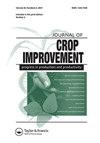Response of banana (Musa spp.) to drought stress based on phenotypic and physiological traits
IF 1.5
Q3 AGRONOMY
引用次数: 0
Abstract
ABSTRACT Banana (Musa spp.), an important staple food in the tropical and subtropical regions, is highly susceptible to drought. Developing drought-tolerant bananas using available germplasm offers a long-term solution to mitigate drought effects. The East and Central Africa Banana Germplasm Collection in Uganda contains genetically diverse genotypes whose potential for drought tolerance breeding is yet to be established. This study aimed to determine the response of 14 Musa spp. genotypes to drought stress using phenotypic and physiological traits in order to select promising genotypes for use in breeding. Two genotypes with a known reaction to water deficit conditions were included as local checks. Three-month-old tissue culture-derived plantlets were completely deprived of water for four weeks while control plants were regularly irrigated back to field capacity, and both sets maintained under screen-house conditions. Drought stress resulted in significant reductions in plant height, total leaf area, number of leaf cigars and functional leaves, total dry matter, chlorophyll and relative water content. Water use efficiency (WUE) of 12 genotypes increased under stress conditions. Stomatal conductance was affected by the genotype-porometer reading time interaction. Genotype “ITC.0987” was the most tolerant, considering that moisture stress had the least effect on its above-ground growth. Among the improved diploids, “TMB2x9722-1” had the least total dry matter reduction and highest WUE, while “TMB2x9172” showed the least decrease in relative water content and highest root-shoot ratio increase under stress. Thus, “ITC.0987”, “TMB2x9722-1” and “TMB2x9172” are essential drought-tolerant candidates that may be utilized in breeding.基于表型和生理性状的香蕉对干旱胁迫的响应
香蕉(Musa spp.)是热带和亚热带地区重要的粮食作物,极易受到干旱的影响。利用现有的种质资源培育耐旱香蕉是缓解干旱影响的长期解决方案。乌干达的东非和中非香蕉种质收集包含遗传多样性基因型,其耐旱育种的潜力尚未确定。本研究旨在利用表型和生理性状分析14个穆萨基因型对干旱胁迫的响应,以期筛选出有潜力的基因型用于育种。两种已知对缺水条件有反应的基因型被纳入局部检查。3个月大的组织培养植株被完全剥夺水分4周,而对照植株被定期灌溉以恢复田间容量,两组植株都保持在纱棚条件下。干旱胁迫导致植株高度、总叶面积、叶雪数和功能叶数、总干物质、叶绿素和相对含水量显著降低。胁迫条件下12个基因型的水分利用效率(WUE)均有所提高。气孔导度受基因型-测气孔时间互作的影响。基因型”ITC。考虑到水分胁迫对其地上生长的影响最小,0987”的耐受性最强。改良二倍体中,“TMB2x9722-1”的总干物质减少量最小,水分利用效率最高,而“TMB2x9172”的相对含水量减少量最小,根冠比增加量最高。因此,“ITC。0987”,“TMB2x9722-1”和“TMB2x9172”是可用于育种的重要耐旱候选者。
本文章由计算机程序翻译,如有差异,请以英文原文为准。
求助全文
约1分钟内获得全文
求助全文
来源期刊

Journal of Crop Improvement
Multiple-
CiteScore
3.30
自引率
7.70%
发文量
42
期刊介绍:
Journal of Crop Science and Biotechnology (JCSB) is a peer-reviewed international journal published four times a year. JCSB publishes novel and advanced original research articles on topics related to the production science of field crops and resource plants, including cropping systems, sustainable agriculture, environmental change, post-harvest management, biodiversity, crop improvement, and recent advances in physiology and molecular biology. Also covered are related subjects in a wide range of sciences such as the ecological and physiological aspects of crop production and genetic, breeding, and biotechnological approaches for crop improvement.
 求助内容:
求助内容: 应助结果提醒方式:
应助结果提醒方式:


